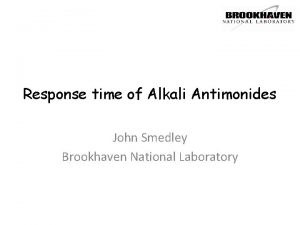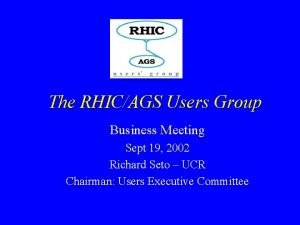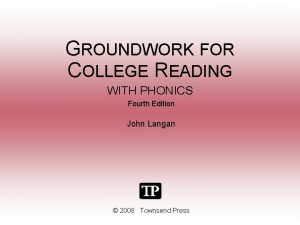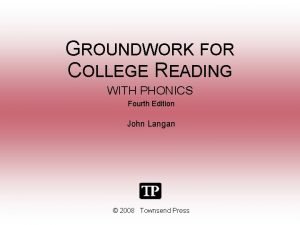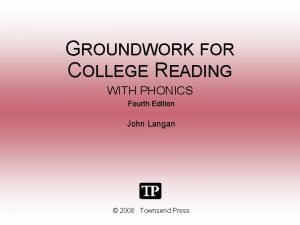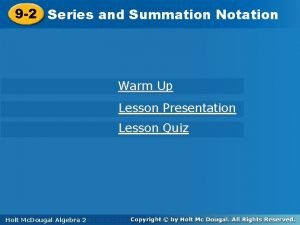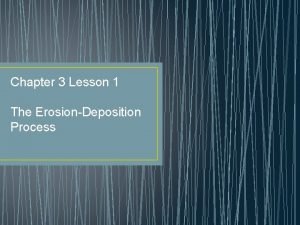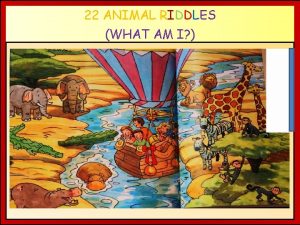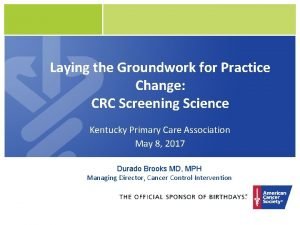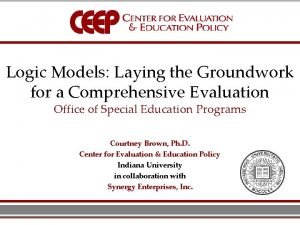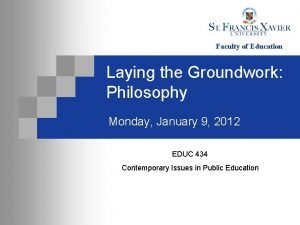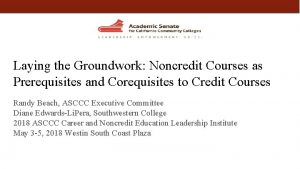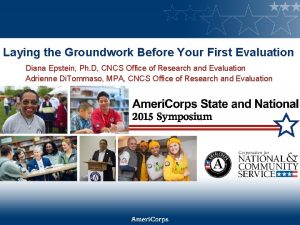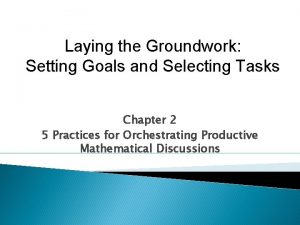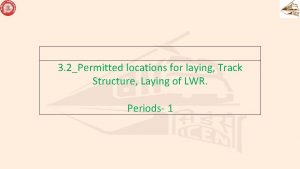Laying the groundwork at the AGS Recent results





























- Slides: 29

Laying the groundwork at the AGS: Recent results from E 895 Mike Lisa, for the E 895 Collaboration N. N. Ajitanand, J. Alexander, D. Best, P. Brady, T. Case, B. Caskey, D. Cebra, J. Chance, P. Chung, B. Cole, K. Crowe, A. Das, J. Draper, S. Gushue, M. Gilkes, M. Heffner, H. Hiejima, A. Hirsch, E. Hjort, L. Huo, M. Justice, M. Kaplan, J. Klay, D. Keane, J. Kintner, D. Krofcheck, R. Lacey, J. Lauret, E. Le. Bras, M. Lisa, H. Liu, Y. Liu, B. Mc. Grath, Z. Milosevich, D. Olson, S. Panitkin, C. Pinkenburg, N. Porile, G. Rai, H. -G. Ritter, J. Romero, R. Scharenberg, L. Schroeder, B. Srivastava, N. Stone, J. Symons, S. Wang, R. Wells, J. Whitfield, T. Wienold, R. Witt, L. Wood, X. Yang, Y. Zhang, W. Zhang Auckland - BNL - CMU - Columbia - UC Davis - Harbin - KSU - LBL St. Mary’s College - OSU - Purdue - Stony Brook E 895 Mike Lisa, Quark Matter 2001 1

Reminder: why AGS is (still) interesting spp before E 895 Fy · sets baseline systematics “your systematics deviate from what? ” v 2 · the “other” extreme condition - maximum baryon density · probe medium & bulk b effects · transition region for bulk properties E 895 T Mike Lisa, Quark Matter 2001 Ebeam 2

This talk Not a “final wrap-up” of E 895, which is still alive. Since QM 99: • • • PRL 83 1295 (1999) PRL 84 2798 (2000) PRL 84 5488 (2000) PRL 85 940 (2000) PLB 496 1 (2000) PRL accepted (2000) E 895 Transition from out-of-plane to in-plane elliptic flow Bombarding energy dependence of p- HBT at the AGS Sideward flow in Au+Au collisions at 2 -8 AGe. V Anti-flow of K 0 mesons in 6 AGe. V Au+Au collisions Azimuthal dependence of pion interferometry flow in 2 -6 AGe. V Au+Au collisions • Published E 895 flow • Beyond proton flow - collective flow of strange particles • Geometrical dependence of flow • HBT Beyond “Rp = 5 fm” • geometric aspects of collective flow • 6 D phasespace density • -p correlations • Summary Mike Lisa, Quark Matter 2001 3

Measurement with the EOS TPC • Up to ~350 particles/event measured over large phase space • Good reaction plane resolution • p/p 3% (dominated by MCS) E 895 “Grandfather of STAR TPC” Mike Lisa, Quark Matter 2001 4

p phasespace density The Four Fundamental Corners of E 895 thermal population? multiparticle effects? poster by D. Cebra space-time geometry & dynamics thermal/chemical properties PRL 84 2798 (2000) poster by J. Klay tilted sources geometry of anisotropic flow -p correlations baryon source geometry two-hadron potential PLB 496 1 (2000) poster by U. Heinz pre-equilibrium dynamics collective bulk response equation of state E 895 PRL 83 1295 (1999) PRL 84 5488 (2000) strange/nonstrange radial flow distinct freezeout? talk by C. Pinkenburg , K 0 flow strange potentials PRL 85 940 (2000) PRL, in press talk by. Quark C. Pinkenburg Mike Lisa, Matter 2001 early thermochemistry strange potentials talk by C. Pinkenburg 5

sideward flow elliptic flow F (Ge. V/c) Reminder from QM 99: Proton Flow 0. 3 0. 2 0. 1 0 0. 04 10 1 Elab (AGe. V) 10 v 2 · Transition region for flow mapped Momentum space · F drops as presonances dominate y px · Strong sensitivity to medium contributions to pressure q. F · No single parameterization p z reproduces flow details (Beam) plane · No sudden drops Reaction in pressure (flow) signaling phase transition 0 -0. 04 -0. 08 E 895 1 1 Elab (AGe. V) 10 Mike Lisa, Quark Matter 2001 PRL 83 1295 (1999) PRL 84 54886(2000)

Beyond protons. . . neural networks identify decays of neutral strange particles production excitation function L Minv (Ge. V/c 2) • (p+p) • 179 E 895 1. 08 1. 10 1. 12 1. 14 2) see 2001 talk of Chris Pinkenburg 7 today MMike Lisa, Quark Matter inv (Ge. V/c

flow • “positive” flow • decreases with Eb (more than p) 2 AGe. V px (Ge. V/c) • RQMD (without potential) underpredicts effect • probe potential at high r (complements hypernuclei studies) astrophysical models 4 AGe. V “quark counting” 6 AGe. V E 895 y/ycm PRL accepted (2000) see 2001 talk Mike Lisa, Quark Matter of Chris Pinkenburg 8 today

K 0 S (anti-)flow Surprise— strong antiflow • grows with collision energy px (Ge. V/c) 0. 1 S. Pal et al, PR C 62 061903 (2000) 0 -0. 1 6 Ge. V -1. 0 data RQMD (2. 3) 4 Ge. V data -0. 5 0 y/ycm 0. 5 1. 0 Transport models: • rescattering insufficient (results in positive flow) • strong repulsive vector potential required E 895 PRL 85 940 (2000) see 2001 talk Mike Lisa, Quark Matter of Chris Pinkenburg 9 today

proton elliptic flow - varying the geometry 0 -. 02 2 AGe. V -. 04 D . 02 v 2 “min-bias” flow measurements do not constrain models geometry provides another handle on flow 4 AGe. V 0 increasing spatial asymmetry produces larger signal -. 02 6 AGe. V. 01 -. 01 0 E 895 Can HBT give geometrical information on flow? ? 2 4 b (fm) 6 8 Mike Lisa, Quark Matter 2001 10

HBT: probing freeze-out space-time structure I - Cylindrical sources K Rside E 895 Rout HBT @ AGS mapped by E 895 (QM 99) PRL 84, 2798 (2000) NPALisa, 661, 444 c (1999) Mike Quark Matter 2001 11

HBT: probing freeze-out space-time structure II - Collisions at b 0 side • Source in b-fixed system: (x, y, z) • Space/time entangled in pair system (x. O, x. S, x. L) y K out f b x (several terms vanish @ p. T = y = 0) E 895 U. Wiedemann, PRC 57, 266 (1998) MAL, U. Heinz, U. Wiedemann PLB 489, 287 (2000) Poster by U. Heinz Mike Lisa, Quark. See Matter 2001 12

First-order information in HBT(f) y 2 nd-harmonic oscillations from elliptical transverse shape b x 1 st-harmonic oscillations: spatial tilt angle q. S y x qs E 895 z (Beam) Coordinate space! Mike Lisa, Quark Matter 2001 13

Data: p- correlation functions Au(4 AGe. V)Au, b 4 -8 fm 2 D projections f ( ) C(q) 1 D projections, f=45° out side long lines: projections of 3 D Gaussian fit • 6 components to radius tensor: i, j = o, s, l E 895, PLB 496 1 (2000) Mike Lisa, Quark Matter 2001 14

Cross-term radii Rol, Ros, Rsl quantify “tilts” in correlation functions f ( ) fit results to correlation functions Lines: Simultaneous fit to HBT radii to extract underlying Mike Lisa, Quarkgeometry Matter 2001 E 895 15

Images of p--emitting sources (scaled ~ x 1014) y similar to naïve overlap: b~5 fm x’ z q. S=47° x’ x’ 2 AGe. V 3 fm y y 4 AGe. V z 6 AGe. V q. S=37° z q. S=33° Large, positive tilt angles E 895 x Mike Lisa, Quark Matter 2001 x x 16

Opposing average tilts in p, x and the physics of p flow p+ 6 AGe. V • p “antiflow” (negative tilt in p-space) • x-space tilt in positive direction non-hydro nature of p flow z (fm) RQMD transport model: • Antiflow reflects dense region z~0 • (dilute large-|z| show positive flow) B. Caskey pion momentum anisotropies due to reflection from flowing baryons (p. N D p. N) p tilt reflects x-space structure of proton flow E 895 Bass et al [PLB 302 381 (93)]: Mike Lisa, Quark Matter 2001 RQMD Au(2 Ge. V)Au x (fm) 17

Tomography in 6 Dimensions Flow analysis and HBT relative to the reaction plane allow a complete characterization of the final state in phase space, get space-momentum correlations 6 dimensional Tomography of proton flow 6 AGe. V Momentum Space (Flow) pz py Tiny flow angle px E 895 Coordinate Space (HBT) z positive v 2 px y Large tilt Mike Lisa, Quark Matter 2001 x Out-of-plane x’ 18

More on position - momentum space relationship the phasespace density f = occupation of 6 -D position momentum cell, volume h 3 • determines magnitude of multi-particle correlations (lasers) • provides a test of thermalization/consistency T determines number of p, as well as spectral shape Experimental access to spatially averaged density volume in p-space volume in x-space G. Bertsch, PRL 72 2349 (94) D. Ferenc et al, PL B 457 347 (99) • observation @ SPS, AGS: “Universal” p freeze-out density E 895 • breaks down at lower Mike energies? Lisa, Quark Matter 2001 19

Measured phasespace densities • non-universal growth of f with collision energy • f<1 no condensate E 895 preliminary Mike Lisa, Quark Matter 2001 midrapidity central collisions 20

Measured phasespace densities • non-universal growth of f with collision energy • f<1 no condensate • low-p. T saturation of f as Ebeam 8 AGe. V • same occupancy as STAR! E 895 preliminary Mike Lisa, Quark Matter 2001 midrapidity central collisions 21

Measured phasespace densities • non-universal growth of f with collision energy • f<1 no condensate • low-p. T saturation of f as Ebeam 8 AGe. V • same occupancy as STAR! • Rough agreement with thermal Bose-Einstein • high-p. T excess @ high Eb E 895 preliminary Mike Lisa, Quark Matter 2001 midrapidity central collisions 22

Measured phasespace densities • non-universal growth of f with collision energy • f<1 no condensate • low-p. T saturation of f as Ebeam 8 AGe. V • same occupancy as STAR! • Rough agreement with thermal Bose-Einstein • high-p. T excess @ high Eb • Better description by inclusion of radial flow [B. Tomasik, Ph. D. thesis] • Substantial experimental & theoretical uncertainties E 895 preliminary also see poster of D. Cebra Mike Lisa, Quark Matter 2001 midrapidity central collisions 23

Baryon correlations C 2 • p more sensitive than pp? 1. 2 • Correct p potential? 1. 8 1. 0 1. 6 0. 8 1. 4 2 AGe. V 4 AGe. V 6 AGe. V O 8 AGe. V 0. 6 1. 2 1. 0 C 2 0. 4 pp correlation function (central collisions, y<ycm) 0. 2 0 -p 0 0. 4 0. 8 0. 12 k (Ge. V/c) • pp correlations ~ Ebeam independent • another handle on baryon source? E 895 1. 2 p-p 1. 0 0. 8 0. 6 0. 4 0. 2 0 20 40 k (Me. V/c) Wang & S. Pratt PRL 83 3139 Mike Lisa, Quark Matter. F. 2001 24 (1999)

Another E 895 first: -p correlation function • positive correlation observed 1. 4 • work in progress… E 895 1. 0 C(k) • qualitatively different shape than expected from Urbana p- potential input to the particle physics 0. 6 1. 4 1. 0 0. 6 0 20 Mike Lisa, Quark Matter 2001 40 60 80 100 k (Me. V/c) 25

Summary I • continuing to push the envelope… • directed and elliptic flow excitation function • continue input to bulk parameterization • strange particle flow • positive flow • does not scale with proton flow (naïve 2/3 rule broken) • potential important to describe flow • strong antiflow of K 0’s • strong, repulsive vector potential indicated • Varying geometry (impact parameter): another handle • increased x asymmetry larger p asymmetry E 895 Mike Lisa, Quark Matter 2001 26

Summary II • azimuthally-sensitive p- HBT • almond-shaped source, (~ entrance-channel geometry) • large positive spatial tilt angles • non-hydro nature of p flow • coordinate-space structure of proton flow • 6 -D p phasespace density • non-universal growth of <f> with energy • saturation to “universal” behaviour at 8 AGe. V • after 8 AGe. V, increased p yield pushed to high p. T flow • first p- signal observed • significant positive correlation • inconsistent with shape expected by Urbana potential E 895 Mike Lisa, Quark Matter 2001 27

More E 895 @ QM 01 · Production & Collective Behaviour of Strange Particles Parallel session today: Chris Pinkenburg · p Phasespace Density & Source Charge Density P 063 Dan Cebra · Directed, Elliptic, Radial, & Longitudinal Flow P 069 Jenn Klay · Azimuthally-sensitive HBT and the Tilt of the p Source P 018 Ulrich Heinz* E 895 Mike Lisa, Quark Matter 2001 * honorary E 895 member 28

Pion and proton elliptic flow E 895 Mike Lisa, Quark Matter 2001 W. Caskey, DNP 98 • Ellitpic flow of both positive and negative pions follows the trends of the protons 29
 A friend emails you the results of a recent high school
A friend emails you the results of a recent high school Goto/ags
Goto/ags Laying the tablecloth
Laying the tablecloth John smedley ags
John smedley ags Ags logins
Ags logins Rhic ags users meeting 2020
Rhic ags users meeting 2020 Role of hr in change management
Role of hr in change management Groundwork for college reading
Groundwork for college reading Rwd html
Rwd html Major and minor supporting details
Major and minor supporting details Groundwork for college reading
Groundwork for college reading Summation notation
Summation notation Egg laying animals
Egg laying animals Flowers laying on table
Flowers laying on table Lay aside all malice
Lay aside all malice Lesson outline the erosion-deposition process answer key
Lesson outline the erosion-deposition process answer key Lay aside every weight and sin
Lay aside every weight and sin Feathers, laying eggs, small, i can sing & fly
Feathers, laying eggs, small, i can sing & fly Characteristics of quality culture
Characteristics of quality culture You have 100 coins laying flat on a table
You have 100 coins laying flat on a table Ap synthesis prompt
Ap synthesis prompt Recent demographic changes in the uk
Recent demographic changes in the uk After a skydiving accident laurie
After a skydiving accident laurie Recent trends in ic engine
Recent trends in ic engine Udin login
Udin login Recent trends in foreign trade
Recent trends in foreign trade Schoology myips login
Schoology myips login Recent advances in dental ceramics
Recent advances in dental ceramics Recent developments in ict
Recent developments in ict Mis trends
Mis trends



